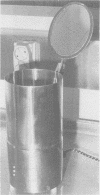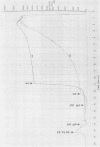Abstract
A comparative study of formaldehyde (HCHO) fumigation was carried out by controlled vaporization, using an electric vapor generator, and by the Formalin-permanganate method. Determination of vapor levels as well as bactericidal action showed the generator to be more effective. Maximum achievable fumigant levels were temperature dependent and related to the equilibrium vapor concentration of HCHO. At a room temperature of 21 degrees C, vaporization of more than 2,000 micrograms of HCHO per liter resulted in conversion of HCHO to paraformaldehyde, which condensed on surfaces and contributed to prolonged residual vapor levels. An electronic monitor is described which is capable of detecting HCHO levels as low as 10 microgram/liter and can be used to monitor the complete fumigation process.
Full text
PDF







Images in this article
Selected References
These references are in PubMed. This may not be the complete list of references from this article.
- Bartzokas C. A., McCarthy K., Shackleton W. B., Baker B. F. Observations on the effects of formaldehyde on cockroaches and their flora: I. Survival of vaccinia virus-infected cockroaches during fumigation with formaldehyde. J Hyg (Lond) 1978 Feb;80(1):125–129. doi: 10.1017/s0022172400053444. [DOI] [PMC free article] [PubMed] [Google Scholar]
- Braswell J. R., Spiner D. R., Hoffman R. K. Adsorption of formaldehyde by various surfaces during gaseous decontamination. Appl Microbiol. 1970 Nov;20(5):765–769. doi: 10.1128/am.20.5.765-769.1970. [DOI] [PMC free article] [PubMed] [Google Scholar]
- Hoffman R. K., Spiner D. R. Effect of relative humidity on the penetrability and sporicidal activity of formaldehyde. Appl Microbiol. 1970 Oct;20(4):616–619. doi: 10.1128/am.20.4.616-619.1970. [DOI] [PMC free article] [PubMed] [Google Scholar]
- Lapen R. F., Kenzy S. G. Effect of selected environmental treatments on the incidence of gross Marek's disease lesions in chickens. Poult Sci. 1975 May;54(3):659–663. doi: 10.3382/ps.0540659. [DOI] [PubMed] [Google Scholar]
- Schilling B., Weuffen W., Wigert H. Untersuchungen über den Einsatz von Paraformaldehydtabletten zur Keimzahlverminderung, Desinfektion, Kaltsterilisation und Sterilaufbewahrung von ärztlichem Instrumentarium. 2. Mitteilung: Bestimmung des aus Paraformaldehydtabletten in die Gasphase abgegebenen Formaldehyde. Pharmazie. 1978 Feb-Mar;33(2-3):103–104. [PubMed] [Google Scholar]
- Tucker J. F., Harry E. G., Wainman H. E. The effect of fumigation with methyl bromide or formaldehyde on the infectivity of poultry house litter naturally contaminated with Salmonella virchow. Br Vet J. 1975 Jul-Aug;131(4):474–485. doi: 10.1016/s0007-1935(17)35243-0. [DOI] [PubMed] [Google Scholar]





